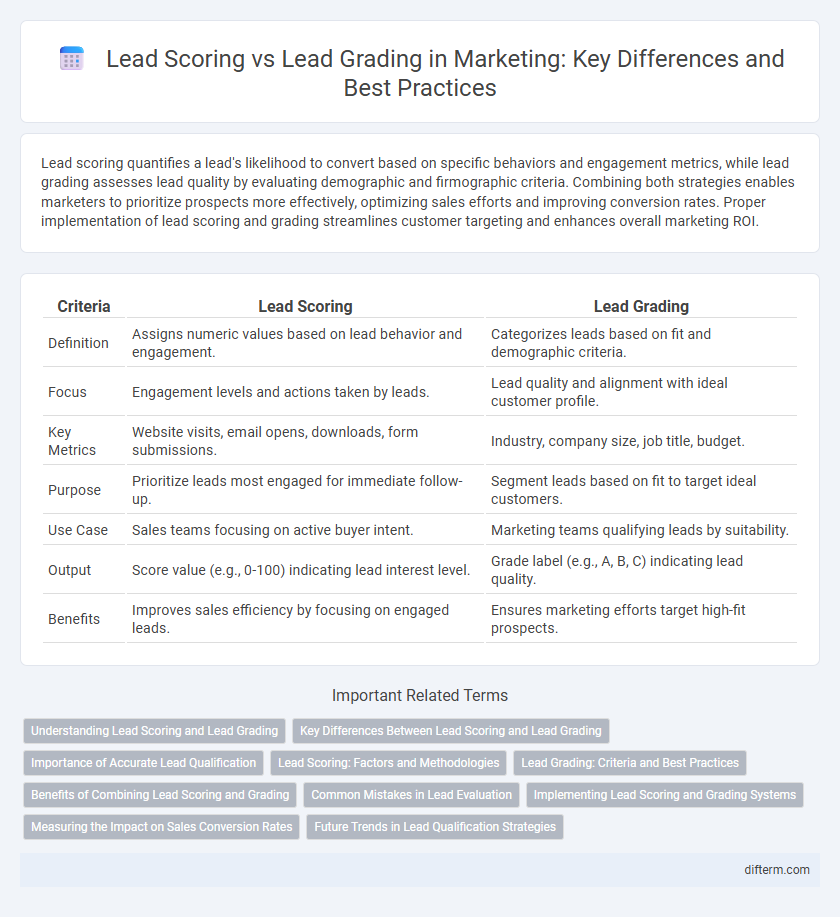Lead scoring quantifies a lead's likelihood to convert based on specific behaviors and engagement metrics, while lead grading assesses lead quality by evaluating demographic and firmographic criteria. Combining both strategies enables marketers to prioritize prospects more effectively, optimizing sales efforts and improving conversion rates. Proper implementation of lead scoring and grading streamlines customer targeting and enhances overall marketing ROI.
Table of Comparison
| Criteria | Lead Scoring | Lead Grading |
|---|---|---|
| Definition | Assigns numeric values based on lead behavior and engagement. | Categorizes leads based on fit and demographic criteria. |
| Focus | Engagement levels and actions taken by leads. | Lead quality and alignment with ideal customer profile. |
| Key Metrics | Website visits, email opens, downloads, form submissions. | Industry, company size, job title, budget. |
| Purpose | Prioritize leads most engaged for immediate follow-up. | Segment leads based on fit to target ideal customers. |
| Use Case | Sales teams focusing on active buyer intent. | Marketing teams qualifying leads by suitability. |
| Output | Score value (e.g., 0-100) indicating lead interest level. | Grade label (e.g., A, B, C) indicating lead quality. |
| Benefits | Improves sales efficiency by focusing on engaged leads. | Ensures marketing efforts target high-fit prospects. |
Understanding Lead Scoring and Lead Grading
Lead scoring quantifies a prospect's likelihood to convert by assigning numerical values based on behavior, engagement, and demographic data, enabling marketers to prioritize high-potential leads. Lead grading categorizes leads by fit and quality using criteria such as job title, industry, and company size to assess how well a prospect matches the ideal customer profile. Understanding the distinction between lead scoring and lead grading enhances targeted marketing strategies and optimizes sales efforts by aligning outreach with lead readiness and relevance.
Key Differences Between Lead Scoring and Lead Grading
Lead scoring quantifies a prospect's engagement and behavior using numerical values based on actions such as email opens, website visits, and content downloads. Lead grading evaluates a lead's demographic and firmographic fit, like job title, company size, and industry alignment, to determine suitability for the product or service. The primary difference lies in lead scoring's focus on activity-based qualification, while lead grading emphasizes profile-based qualification, enabling marketers to prioritize leads more effectively.
Importance of Accurate Lead Qualification
Accurate lead qualification drives marketing efficiency by distinguishing high-potential prospects through lead scoring, which quantifies engagement levels and behaviors, versus lead grading, which evaluates fit based on demographic and firmographic data. Implementing precise lead scoring and grading models enhances sales conversion rates by prioritizing leads that are both interested and ideally matched to product offerings. Optimizing lead qualification reduces wasted resources, accelerates sales cycles, and improves ROI across marketing campaigns.
Lead Scoring: Factors and Methodologies
Lead scoring evaluates potential customers by assigning numerical values based on behaviors such as website visits, email engagement, and social media interactions, enabling marketers to prioritize highly engaged leads. Key factors include demographic data, buying signals, and past interaction history, combined through methodologies like predictive analytics and machine learning algorithms. This systematic approach improves sales efficiency by identifying prospects with the highest likelihood to convert.
Lead Grading: Criteria and Best Practices
Lead grading categorizes leads based on qualitative criteria such as company size, job role, and industry relevance to prioritize high-value prospects. Effective lead grading requires aligning scoring models with buyer personas and sales team feedback to refine and validate the criteria continuously. Best practices include regularly updating grading parameters based on market changes and integrating CRM data for accurate, actionable insights.
Benefits of Combining Lead Scoring and Grading
Combining lead scoring and lead grading provides a comprehensive approach to prioritize prospects by both their engagement level and fit with the ideal customer profile, enhancing sales efficiency and targeting accuracy. This integrated method improves lead qualification, enabling marketing teams to tailor nurturing strategies and increase conversion rates. Leveraging data from behavioral analytics (lead scoring) alongside demographic and firmographic criteria (lead grading) optimizes resource allocation and maximizes return on marketing investment.
Common Mistakes in Lead Evaluation
Lead scoring often suffers from overreliance on quantitative metrics, neglecting qualitative factors, while lead grading mistakes arise from inconsistent criteria application across sales and marketing teams. Failing to align lead evaluation methods with buyer personas and sales stages can lead to misclassified leads, reducing conversion efficiency. Regular calibration of scoring models and grading standards improves accuracy in prioritizing high-potential prospects.
Implementing Lead Scoring and Grading Systems
Implementing lead scoring and grading systems enhances marketing efficiency by quantitatively evaluating prospects based on behavior and demographic criteria. Lead scoring assigns numerical values to interactions such as website visits and email opens, while lead grading categorizes leads by fit, considering factors like company size and job title. Integrating these systems enables targeted campaigns and prioritizes high-potential leads, improving conversion rates and sales alignment.
Measuring the Impact on Sales Conversion Rates
Lead scoring quantifies prospects based on engagement and behavior, enabling precise identification of high-potential leads that increases sales conversion rates by targeting resources effectively. Lead grading assesses leads through demographic and firmographic criteria, ensuring alignment with ideal customer profiles which enhances conversion accuracy. Combining lead scoring and grading provides a comprehensive evaluation, maximizing sales efficiency and significantly boosting conversion performance.
Future Trends in Lead Qualification Strategies
Future trends in lead qualification strategies emphasize the integration of AI-powered lead scoring systems that analyze real-time behavioral data and predictive analytics to enhance accuracy. Lead grading is evolving to incorporate dynamic criteria based on customer personas and market segmentation, enabling personalized engagement. Advanced platforms combine both lead scoring and grading for a holistic approach, improving conversion rates and marketing efficiency.
Lead scoring vs lead grading Infographic

 difterm.com
difterm.com